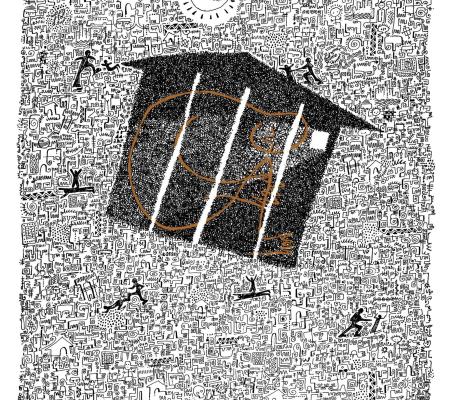As an illustrator working at the government-owned Daily Times of Nigeria Limited (DTN) between 1990 and 1998, artist Victor Ekpuk navigated a delicate political terrain of the second military government in Nigeria. Prior to his arrival, Nigerian Head of State Ibrahim Babangida (1985-1993) had clamped down on press freedoms, and over the next eight years, Babangida and his successor, Sani Abacha (1993-1998), engaged in an aggressive systematic attack on the media. Ekpuk took calculated risks while working within the highly regulated space of DTN, and in a series of illustrations, he employed cutting visual satire, metaphor and irony to criticize the corrupt political apparatus of the second military government. In some instances, he used conventional cartoon techniques, such as caricature, as his primary vehicle for critique. In others, he deviated from such established conventions, and, adhering more closely to widespread indigenous West African principles, filled the spaces with nsibidi, an ideographic script from southeast Nigeria, and his own related invented script. I argue that, despite the methodological parallels, the illustrations offered distinct forms of critique: the first, singular and pointed, and the second, expansive and open-ended. The two operated in tandem, forming a sophisticated multi-layered commentary on the military government and the economic and political disparity in the country.
Janine A. Sytsma, Ph.D., specializes in Arts of Africa and the African Diaspora with an emphasis on contemporary art within the context of global geopolitics. Her current book project, Departures: The Ife Art School, Postcolonial Modernism, and Global Contemporary Art, offers the first extensive study of the Ife Art School at Obafemi Awolowo University, Ile-Ife, Nigeria, enriching understandings of postcolonial modernism in Nigeria and contributing to existing discourse on Africa in the global field of contemporary visual art. She also has several related articles, including “For Learning and Culture: The Early History of Art Training at the University of Ife,” in Critical Interventions: Journal of African Art History and Visual Culture; “Mythopoeic Futures: A Critical Examination of Moyo Ogundipe’s Paintings,” forthcoming in African Arts; “The Nigeria Pavilion: Visual Counternarratives at the Venice Biennale,” in TOJA: The OYASAF of Art Journal; and “African Art, the Venice Biennale, and the Politics of Visibility” forthcoming in the Routledge Encyclopedia of African Studies series.
Sytsma’s research has been supported by a Cambridge Faculty Fellowship, 2019-2020, a CIC-Smithsonian Institution Predoctoral Fellowship in 2011-2012, a Fulbright-Hays DDRA Fellowship in 2010-2011, and an Omooba Yemisi Adedoyin Shyllon Art Foundation Fellowship, in 2009, among numerous other grants. She holds a Ph.D. in Art History with a Minor in African American Studies from the University of Wisconsin at Madison, an MA in Art History from the University of Denver, and a BA in Art History from Arizona State University.


